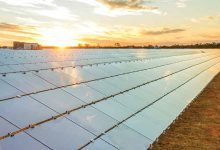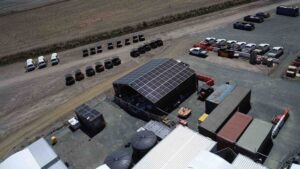Australian investors in solar energy projects are being forced to look for opportunities overseas as a slowdown in projects locally has created stiff competition between project buyers, and investment returns are getting squeezed as a result.
ASX listed New Energy Solar sees its best opportunities for expanding its portfolio of solar project investments in the United States, as the demand for investment opportunities in Australian large-scale solar projects outstrips the supply of new projects being commissioned, it told investors at its Annual General Meeting.
With the cost to acquire projects being driven up by demand, investors have been left with tight profit margins and lower returns from their investments compared to similar projects that can be found in other markets, particularly in the US.
The last few years have seen the emergence of dedicated investment funds that seek ownership in large-scale solar projects, particularly projects that have secured long-term off-take agreements, as these projects are able to generate predictable revenue and provide a zero-emissions investment option for ethical investors, and a guaranteed return for infrastructure investors.
New Energy Solar acquired its first Australian asset through the purchase of the 46.7MW Manildra solar farm in central NSW, the project having been developed by First Solar, with the support of the Australian Renewable Energy Agency.
New Energy’s second Australian acquisition is the 111 MW Beryl solar farm in New South Wales, currently undergoing commissioning.
However, in April, New Energy Solar established a $200 million US Solar Fund, which has been specifically designed to grow the company’s lucrative US portfolio as it sees better returns on investment available from US plants.
That is being driven by an attractive policy environment, and tax concessions, with the US solar market now emerging as a much more fertile ground for investors, with projects delivering higher rates of returns to investors.
“The ability to buy well in Australia is far far less than the ability to buy well in the United States,” chairman Jeffrey Whalan said.
New Energy Solar listed the new fund on the London Stock Exchange in April, and the offering was met with strong demand, the company told shareholders at its AGM in Sydney.
“We are very encouraged by the support that the US Solar Fund has gained, with over 30 of the UK’s leading institutional investors participating in the IPO”. Whalan said.
The company launched in Australia in 2015, raising $300 million through its listing on the Australian stock exchange. The fund has sought to develop as a pure-play investment in the large-scale solar sector, building a portfolio of projects delivering steady returns for shareholders.
The most attractive large-scale investments in Australia are those able to secure long-term off-take agreements from large customers. The Beryl solar power station in central NSW, which commenced first generation in April, has secured an offtake agreement to supply the Sydney Metro project.
“We really need that long-term customer contract,” New Energy Solar CEO John Martin told shareholders.
Whalan highlighted the company’s transition from project construction to operation, with the company operating 14 solar power stations across Australia and the United States.
“Since our last annual general meeting, the business has made significant progress from growth to production, with 13 solar plants operating and generating revenue at the end of 2018.”
The company successfully completed the commissioning of a total of nine utility-scale solar plants throughout 2018 and has now amassed a portfolio of 462MW of generation capacity.
The company’s portfolio highlights the better investment environment in the USA, with all but two of the company’s current portfolio of 16 solar plants located in the USA.
New Energy Solar announced strong revenue growth throughout 2018, with underlying revenues growing 94% to US$42 million in 2017. Underlying earnings before tax grew by 88% in the same period to US$32.6 million.
While outlining the results achieved by New Energy Solar through a focus on large-scale solar projects, the company was able to also highlight the environmental benefits that have been generated by the fund’s investments.
“In terms of the environmental dividend, over 2018 the business displaced the equivalent of 1.2kg of CO2 for [share] on issue,” Whalan said in his address.









